

Dix questions, dix réponses sur le changement climatique. Atacama Desert flooded after 7 years of rain fell in just 12 hours. At least 10 people have been killed by catastrophic floods in northern regions of Chile after thunderstorms brought the equivalent of 7 years of rain in just 12 hours on March 26.
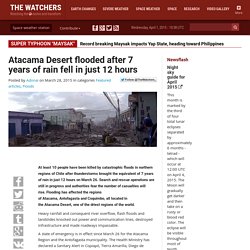
Search and rescue operations are still in progress and authorities fear the number of casualties will rise. Flooding has affected the regions of Atacama, Antofagasta and Coquimbo, all located in the Atacama Desert, one of the driest regions of the world. Heavy rainfall and consequent river overflow, flash floods and landslides knocked out power and communication lines, destroyed infrastructure and made roadways impassable. Arctic ice melt sets yet another record. This story was originally published by Slate and is reproduced here as part of the Climate Desk collaboration.
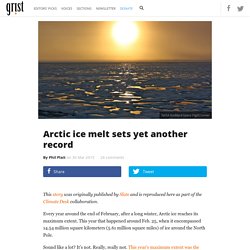
Every year around the end of February, after a long winter, Arctic ice reaches its maximum extent. This year that happened around Feb. 25, when it encompassed 14.54 million square kilometers (5.61 million square miles) of ice around the North Pole. Sound like a lot? Turns out the world’s first “clean coal” plant is a backdoor subsidy to oil producers. The world’s first “clean coal” plant — that is, the first full-size coal-fired power plant ever to capture and store the majority of its CO2 emissions — is located in, of all places, Saskatchewan.

(They should change the name to “Of All Places, Saskatchewan.”) According to the first financial analysis done on the project, it appears to be functioning primarily as a public subsidy to the province’s aging oil industry. This takes a little explanation. CLER - Base de données documentaires. Le dieu pétrole dévore le Canada, par Nancy Huston. Watch us explain ocean acidification with a soda maker.
A second giant blob of Antarctic ice is getting ready to drown us. Remember when we found out last year that the West Antarctic ice sheet had started to collapse, that the collapse more or less can’t be stopped, and that it will eventually result in 10 to 15 feet of sea-level rise?
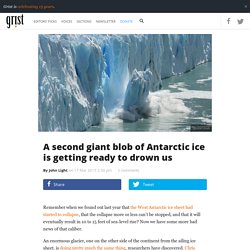
Now we have some more bad news of that caliber. An enormous glacier, one on the other side of the continent from the ailing ice sheet, is doing pretty much the same thing, researchers have discovered. Chris Mooney reports for The Washington Post: The findings about East Antarctica emerge from a new paper just out in Nature Geoscience by an international team of scientists representing the United States, Britain, France, and Australia. They flew a number of research flights over the Totten Glacier of East Antarctica — the fastest-thinning sector of the world’s largest ice sheet — and took a variety of measurements to try to figure out the reasons behind its retreat. Vanuatu’s president blames climate change for Cyclone Pam. This story was originally published by The Guardian and is reproduced here as part of the Climate Desk collaboration.
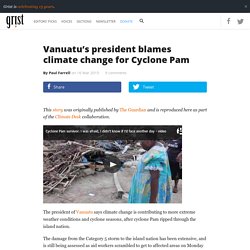
The president of Vanuatu says climate change is contributing to more extreme weather conditions and cyclone seasons, after cyclone Pam ripped through the island nation. The damage from the Category 5 storm to the island nation has been extensive, and is still being assessed as aid workers scrambled to get to affected areas on Monday morning. The official death toll remains at six, with many more injured, and is expected to rise as communication begins to be restored. Vanuatu’s president, Baldwin Lonsdale, spoke at a United Nations world conference in Sendai, Japan, on March 16, and said the storm was a major setback for the people, virtually wiping out Vanuatu’s development. “This is a very devastating cyclone … I term it a monster that has hit Vanuatu,” he said. Vanuatu's president blames climate change for extreme weather. The president of Vanuatu says climate change is contributing to more extreme weather conditions and cyclone seasons, after cyclone Pam ripped through the island nation.

The damage from the category five storm to the island nation has been extensive, and is still being assessed as aid workers scrambled to get to affected areas on Monday morning. The official death toll remains at six, with many more injured, and is expected to rise as communication begins to be restored. Vanuatu’s president, Baldwin Lonsdale, spoke at a United Nations world conference in Sendai, Japan, on Monday, and said the storm was a major setback for the people, virtually wiping out Vanuatu’s development. “This is a very devastating cyclone … I term it a monster that has hit Vanuatu,” he said. “It is a setback for the government and for the people of Vanuatu … All the development that has taken place has been wiped out.”
Climate change is baking Alaska. Something does seem to be going on in Alaska.
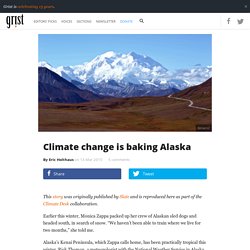
Last fall, a skipjack tuna, which is more likely to be found in the Galápagos than near a glacier, was caught about 150 miles southeast of Anchorage, not far from the Kenai. This past weekend, race organizers had to truck in snow to the ceremonial Iditarod start line in Anchorage. Sen. Italy sets new world one-day snowfall record. Capracotta and Pescocostanzo, between Abruzzo and Molise in central Italy are officially the snowiest places in the world, Meteoweb.eu writes.

While Capracotta, in the province of Isernia, has set the new world one-day snowfall record with 256 cm (8.34 feet) of snow in about 18 hours on Thursday, March 5, 2015, Pescocostanzo measured almost equally impressive 240 cm (7.84 feet). The previous world one-day snowfall record was set in Silver Lake, Colorado, US when 193 cm (6.33 feet) of snow fell between April 20 to 21, 1921. Capracotta, Itally. March 2015. Telerama-FPLP.pdf. Climate change is messing with leaves, and leaves are messing back.
Climate change is a lot like Mr.
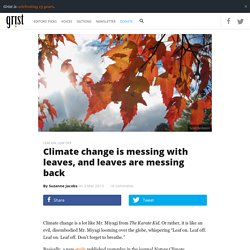
Miyagi from The Karate Kid. Or rather, it is like an evil, disembodied Mr. Miyagi looming over the globe, whispering “Leaf on. Even Europe isn’t doing enough to meet its climate goals. Europe isn’t doing enough to fight climate change, according to a report out today from the European Environment Agency — and that’s bad news for all of the less ambitious nations out there.

While the European Union is on track to meet its 2020 climate goals, it’s not in a good position to continue on after that to meet its 2050 goals, the report found. The E.U. is also falling short on many other sustainability goals. From Reuters: The Copenhagen-based EEA said Europe — backed by some of the toughest environmental legislation in the world — had improved air and water quality, cut greenhouse gas emissions and raised waste recycling in recent years. The E.U. aims to reduce greenhouse gas emissions by 80 to 95 percent by 2050. Chai Jing's review: Under the Dome – Investigating China’s Haze 柴静雾霾调查:穹顶之下. «Sous le dôme», le film sur la pollution qui secoue la Chine.